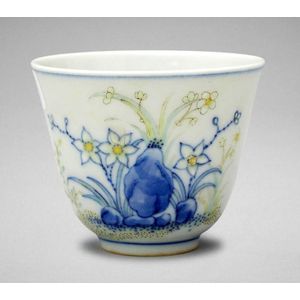Qianlong Mandarin Porcelain Tea Bowl with Court Figures
You must be a subscriber, and be logged in to view price and dealer details.
Subscribe Now to view actual auction price for this item
When you subscribe, you have the option of setting the currency in which to display prices to $Au, $US, $NZ or Stg.
- A/f, as Inspected - The letters "A/F" or "as inspected" as part of a description is the cataloguer's shorthand for "all faults" or "as found", meaning the item has some type of damage or deficiency, it is of uncertain date or provenance, and/or that the seller takes no responsibility for the completeness of the item or the accuracy of the description.
- Gilding - Gilding is a method of ornamentation whereby a thin sheet of gold metal is applied to items made of wood, leather, ceramics, glass and silver for decorative purposes.
For furniture including mirrors, the sheet of gold is usually applied over a coating of gesso. Gesso is a mixture of plaster of Paris and gypsum mixed with water and then applied to the carved wooden frames of mirrors and picture frames as a base for applying the gold leaf. After numerous coats of gesso have been applied, allowed to dry and then sanded a coat of "bole", a usually red coloured mixture of clay and glue is brushed on and allowed to dry, after which the gold leaf is applied. Over time parts of the gilding will rub off so the base colour can be seen. In water gilding, this was generally a blue colour, while in oil gilding, the under layer was often yellow. In Victorian times, gilders frequently used red as a pigment beneath the gold leaf.
Metal was often gilded by a process known as fire gilding. Gold mixed with mercury was applied and heated, causing the mercury to evaporate, the long-term effect of which was to kill or disable the craftsman or woman from mercury poisoning. The pursuit of beauty has claimed many victims, not the least of which were the artists who made those pieces so highly sought after today.
This item has been included into following indexes:
- Chinese ceramics, dynasty mark or period - various items, Qianlong mark (1736-1795) 481
-
Chinese ceramics, item type
- bowls and dishes, other 1,951
- figurines 1,568
- tea bowls 243
Visually similar items

A Chinese porcelain planter, Neatly painted with figures in overglaze, the rounded body curving out from a flat foot, height 20 cm, diameter 15 cm

Fine Chinese porcelain bowl, decorated with figures in out door pursuits, Qianlong seal mark but later, possibly Republic or earlier, 11 cm dia

A large Chinese porcelain bowl, blue and white with peach design and brass fittings around rim. Height 18 cm, diameter 31 cm

A Chinese doucai 'narcissus' wine cup, Tongzhi six-character underglaze blue mark, 4.8 cm high
